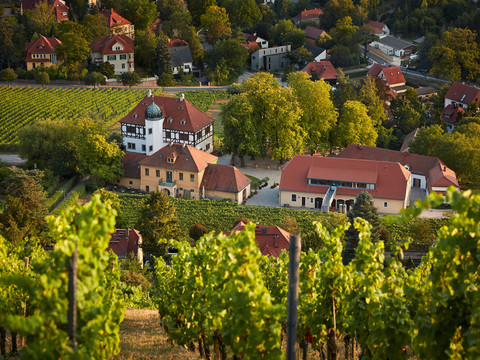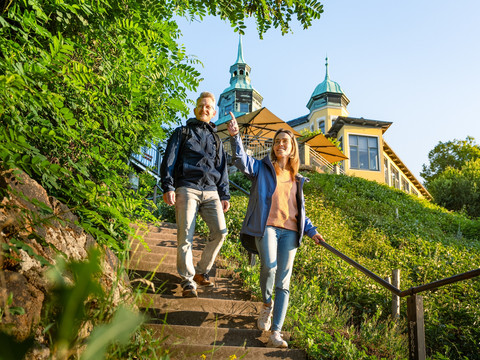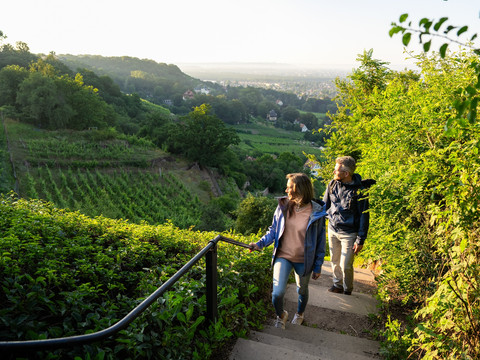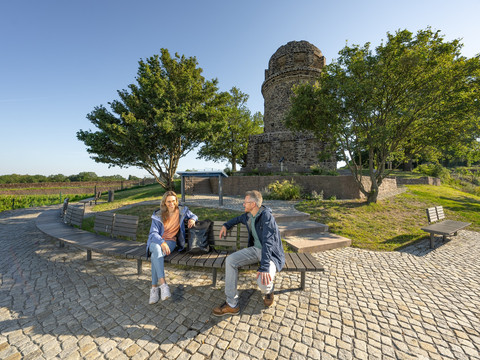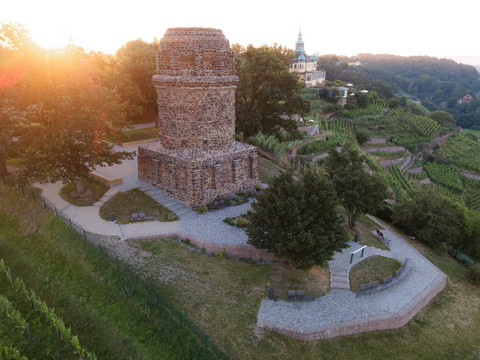From the Dresden, Wilder Mann stop (terminus of streetcar line 3) on Großenhainer Straße, we walk up the street a little until we turn left into Schützenhofstraße. We first walk through the district of Trachau, where viticulture was introduced in 1446. The route leads along asphalt roads through housing estates from the last century and villas on the slopes. Evidence of former viticulture can be found in Schützenhofstraße (vineyard on the "Alter Trachenberge", remains of old walls, terraces and steps) and in Galileistraße (steep former vineyard steps that go up to the right after house no. 50 on Schützenhofstraße).
We follow Galileistraße, turn right into Neuländer Straße (playground), turn left onto Moritzburger Landstraße and cross under the highway. Shortly afterwards, a path on the right leads into the forest and we reach the "Waldmax" restaurant (on Waldhofstraße) on forest paths (crossing Semmelweg, Boxdorfer Weg, a short stretch of Augustusweg, which leads us back to Boxdorfer Weg at the first turning on the right via a forest path).
Behind the restaurant, continue along the forest path to Augustusweg (with hidden vineyard signs (Weinbergstraße, quarry stone walls) to the former "Baumwiese" hotel (at the so-called "Baumwiese" or Boxdorf Baumweise bus stop).
We cross Dresdner Straße, walk a short distance through the forest above the Augustusweg until we meet the Augustusweg and follow it to Radebeul, where a particularly idyllic section of the wine trail begins. Terraced vineyards with 400-year-old quarry stone walls, steep, narrow steps and winegrowers' houses are evidence of the historic winegrowing tradition.
At Eduard-Bilz-Platz, we turn right into Eduard-Bilz-Straße, which merges into Weinbergstraße. Now we also come across the present-day wine industry: on Weinbergstraße, for some residents the most beautiful street in Radebeul, situated directly below the wine terraces, several small wineries are lined up next to each other. Here and there we have the opportunity to sample the rare wines. Blissfully we now discover architectural gems such as the "Haus Sorgenfrei", the former Bilz sanatorium (now apartments) or the "Bennoschlösschen" with its Renaissance gables in the middle of a field of vines.
At Haus Lorenz, a half-timbered winegrower's house dating from 1680, we turn right into Weberstraße, which merges into the narrow Eggersweg. This leads through the "Goldener Wagen" vineyard up to the Spitzhaus (restaurant). From up here, we have an overwhelming view of the Elbe valley, the wine landscape and Radebeul.
Via Spitzhausstraße, we pass the Bismarck Tower and the viewing plateau at its foot. From there, it is only a few steps to the shell pavilion, where we descend the Spitzhaus staircase, the longest staircase in Saxony, to the historic Hoflößnitz vineyard. A longer break is called for here at the latest - to visit the wine museumin the Berg- und Lusthaus or the eco-certified winery with the "Saxon Wine Route" visitor center, which provides information about the entire wine-growing region.
We pass through the large gate to the winery complex via Knohllweg to Hoflößnitzstraße and the striking Meinhold tower house (now the Karl-Friedrich Aust winery). Even though the route now continues on asphalt roads again (Weinbergstr., right into Lößnitzgrundstr., left into Hoflößnitzstr., left into Lößnitzgrundstr., right into Paradies- and Dr.-Rudolf-Friedrichs-Straße, left into Jägerhofstraße, Auf den Bergen, left into Höhenweg, left into Obere Burgstr.), we can enjoy lovingly renovated manor houses and winegrowers' houses time and again. Vineyards line the path and the Radebeul water tower, visible from afar, greets you. After the steep descent (Burgstraße) to the right of the inaccessible Friedensburg castle, we turn right into Obere Bergstraße and pass the 1st Saxon sparkling wine cellar ("Bussard", now a residential park) until we reach the few steps to Moritzburger Straße.
Before we reach Obere Bergstraße, it is worth taking a detour from Burgstraße to turn left into Bodelschwinghstraße and walk almost to its end, where a steep flight of steps leads up on the left (past the Haselbusch broom tavern) to below Friedensburg Castle (private property). From there, standing in the middle of the vineyard, you have a fantastic view of the Elbe valley and Radebeul.
Following Moritzburger Straße downhill, we turn into Mohrenstraße (playground; continues as Auf den Ebenbergen), where we come to the Ebenberge (past the wine tavern "Weinwirtschaft am Neufriedstein"). The "Adolph Diesterweg" planetarium shows us the way down to the Jacobstein, a vineyard pavilion dating from 1743, and finally, past the Belvedere and the vineyard terraces, down to the Saxon State Winery Schloss Wackerbarth with its restaurant and estate market. Europe's first adventure winery offers wine, sparkling wine and park tours with tastings, and the extensive baroque park is open to the public all year round.
We walk past the castle to the western park gate (entrance opposite the restaurant and manufactory), which leads us onto Mittlere Bergstraße, which we walk straight ahead until we reach Hohenhausweg. We turn right onto this path and leave it again at the Hohenhaus (information board; now a residential building; opposite: FeWo Weingut Zechstein, 0351/656 3679) to turn left onto the Zechsteinweg with an educational trail on Saxon grape varieties. Via the Langenbergweg, we reach Mittlere Bergstraße/corner of Gerhart-Hauptmann-Straße a short time later and thus the destination of stage 3 in Radebeul-Zitzschewig (above the Gerhart-Hauptmann-Straße streetcar stop). Not far from the end of the stage, you can stay overnight, for example in the Annelore Große holiday apartment (Mittlere Bergstraße 27c, 0351/838 3434 or 0174/246 3854).
